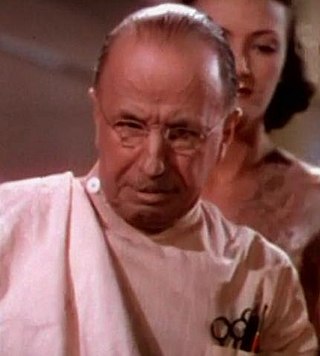Related Research Articles
Robert Florey was a French-American director, screenwriter, film journalist and actor.

Wardell Edwin Bond was an American character actor who appeared in more than 200 films and starred in the NBC television series Wagon Train from 1957 to 1960. Among his best-remembered roles are Bert the cop in Frank Capra's It's a Wonderful Life (1946) and Captain Clayton in John Ford's The Searchers (1956). As a character actor, Bond frequently played cowboys, cops and soldiers.

Edward Santree Brophy was an American character actor and comedian, as well as an assistant director and second unit director during the 1920s. Small of build, balding, and raucous-voiced, he frequently portrayed dumb cops and gangsters, both serious and comic.

Arthur Hoyt was an American film character actor who appeared in more than 275 films in his 34-year film career, about a third of them silent films.

Arthur Edeson, A.S.C. was an American cinematographer. Born in New York City, his career ran from the formative years of the film industry in New York, through the silent era in Hollywood, and the sound era there in the 1930s and 1940s. His work included many landmarks in film history, including The Thief of Bagdad (1924), All Quiet on the Western Front (1930), Frankenstein (1931), The Maltese Falcon (1941), and Casablanca (1942).
Oscar Boetticher Jr., known as Budd Boetticher, was an American film director. He is best remembered for a series of low-budget Westerns he made in the late 1950s starring Randolph Scott.

Nobert Brodine, also credited as Norbert F. Brodin and Norbert Brodin, was an American film cinematographer. The Saint Joseph, Missouri-born cameraman worked on over 100 films in his career before retiring from film making in 1953, at which time he worked exclusively in television until 1960.
George Joseph Folsey, A.S.C., was an American cinematographer who worked on 162 films from 1919 to his retirement in 1976.

Lucien Hubbard was an American film producer and screenwriter.
William Clemens was an American film director.

John Farrell MacDonald was an American character actor and director. He played supporting roles and occasional leads. He appeared in over 325 films over a four-decade career from 1911 to 1951, and directed forty-four silent films from 1912 to 1917.

Lloyd Chauncey Ingraham was an American film actor and director.

John Grant Mitchell Jr. was an American actor. He appeared on Broadway from 1902 to 1939 and appeared in more than 125 films between 1930 and 1948.

George Henry Irving was an American film actor and director.
Blanche Irene Sewell was an American film editor. She was best known mainly for her work at Metro-Goldwyn-Mayer studios from 1925 until her death in 1949.
Arthur Roberts, also known as Arthur E. Roberts, was an American film editor who edited over 100 films during his almost 30-year career.

LeRoy Stone was an American film editor and a screenwriter.

John Hugh Elliott was an American actor who appeared on Broadway and in over 300 films during his career. He worked sporadically during the silent film era, but with the advent of sound his career took off, where he worked constantly for 25 years, finding a particular niche in "B" westerns.
Arruza is a 1968 documentary film about Carlos Arruza directed by Budd Boetticher. It took 10 years to be completed.
L. William O'Connell was an American cinematographer who worked in Hollywood between 1918 and 1950. He frequently worked with directors Howard Hawks and William K. Howard.
References
- 1 2 "Arruza: Detail View". American Film Institute. Archived from the original on July 9, 2017. Retrieved August 15, 2017.
- ↑ Bansak, Edmund G. (2003). Fearing the Dark: The Val Lewton Career. New York: McFarland. pp. 82–83. ISBN 0786417099.
- ↑ "George Crone". American Film Institute. Archived from the original on May 28, 2024. Retrieved August 15, 2017.
- ↑ "At the Alhambra". The Call-Leader (Ellwood, Indiana). August 29, 1922. p. 6. Retrieved August 15, 2017– via Newspapers.com.
